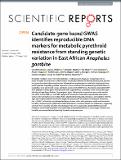| dc.description.abstract | Metabolic resistance to pyrethroid insecticides is widespread in Anopheles mosquitoes and is a major threat to malaria control. DNA markers would aid predictive monitoring of resistance, but few mutations have been discovered outside of insecticide-targeted genes. Isofemale family pools from a wild Ugandan Anopheles gambiae population, from an area where operational pyrethroid failure is suspected, were genotyped using a candidate-gene enriched SNP array. Resistance-associated SNPs were detected in three genes from detoxification superfamilies, in addition to the insecticide target site (the Voltage Gated Sodium Channel gene, Vgsc). The putative associations were confirmed for two of the marker SNPs, in the P450 Cyp4j5 and the esterase Coeae1d by reproducible association with pyrethroid resistance in multiple field collections from Uganda and Kenya, and together with the Vgsc-1014S (kdr) mutation these SNPs explained around 20% of variation in resistance. Moreover, the >20 Mb 2La inversion also showed evidence of association with resistance as did environmental humidity. Sequencing of Cyp4j5 and Coeae1d detected no resistance-linked loss of diversity, suggesting selection from standing variation. Our study provides novel, regionally-validated DNA assays for resistance to the most important insecticide class, and establishes both 2La karyotype variation and humidity as common factors impacting the resistance phenotype. | en_US |

